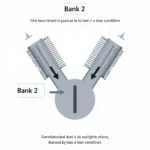Encountering the dreaded check engine light on your dashboard is never a pleasant experience. When your trusty Bluedriver OBD2 scanner throws a P0413 code, it signals an issue with your vehicle’s secondary air injection system. But fear not, understanding this code and its potential causes can empower you to address the problem efficiently.
Demystifying the P0413 Code: What Does it Mean?
In essence, the P0413 code specifically indicates a problem with the secondary air injection system’s switching valve control circuit, typically on Bank 1. This system plays a crucial role in reducing emissions, especially during cold starts. It introduces extra air into the exhaust system, aiding in the catalytic converter’s faster heating and more efficient conversion of harmful pollutants into less harmful substances.
 Bluedriver OBD2 Scanner Diagnosing P0413 Code
Bluedriver OBD2 Scanner Diagnosing P0413 Code
Unraveling the Causes: Why is Your Car Throwing a P0413 Code?
Several culprits could trigger the P0413 code. Here’s a breakdown of the most common causes:
- Faulty Secondary Air Injection Pump: The pump itself could be defective, hindering its ability to supply the required air.
- Malfunctioning Switching Valve: This valve controls the flow of air into the exhaust. If faulty, it disrupts the system’s operation.
- Wiring Issues: Damaged, corroded, or loose wiring within the system’s circuitry can disrupt communication and power supply.
- Vacuum Leaks: The secondary air injection system often relies on vacuum lines for operation. Leaks within these lines can affect its performance.
- Blown Fuse or Relay: A blown fuse or a faulty relay responsible for the system can cause a complete shutdown.
Troubleshooting the P0413 Code with Your Bluedriver OBD2 Scanner
Your Bluedriver OBD2 scanner becomes an invaluable tool in diagnosing the root cause of the P0413 code. Here’s a step-by-step guide:
- Read and Clear the Code: Connect your Bluedriver scanner, retrieve the P0413 code, and clear it.
- Inspect the Secondary Air Injection Pump: Visually inspect the pump for any visible damage or signs of wear.
- Check the Switching Valve: Examine the valve for proper operation and look for any blockages.
- Test the Wiring: Inspect the wiring harness connected to the pump and valve for any breaks, corrosion, or loose connections.
- Inspect Vacuum Lines: Carefully check all vacuum lines associated with the system for leaks or damage.
- Verify Fuse and Relay: Locate and check the relevant fuse and relay for any faults.
Addressing the P0413 Code: Repair or Replace?
Depending on the diagnosed cause, you might need to repair or replace specific components. For instance, damaged wiring might require splicing and soldering, while a faulty pump or valve usually necessitates replacement.
“In my experience, addressing the root cause promptly is key. Ignoring the P0413 code can lead to further damage and costlier repairs down the line,” says John Miller, a veteran automotive technician.
Preventing Future P0413 Codes: Proactive Measures
While not all causes are preventable, some proactive steps can minimize the risk of encountering the P0413 code again:
- Regular Vehicle Maintenance: Adhere to your vehicle’s recommended maintenance schedule, including inspections of the emission system.
- Timely Repairs: Address any minor issues promptly to prevent them from escalating into major problems.
- Quality Parts: When replacing components, always opt for high-quality parts to ensure optimal performance and longevity.
Conclusion: Empowering You to Take Control
The P0413 code, while initially concerning, doesn’t have to be a major headache. Armed with your Bluedriver OBD2 scanner and a better understanding of the secondary air injection system, you can confidently diagnose and address the issue. Remember, prompt action and regular maintenance are key to keeping your vehicle running smoothly and efficiently for miles to come.

